KACHIN SOCIETY
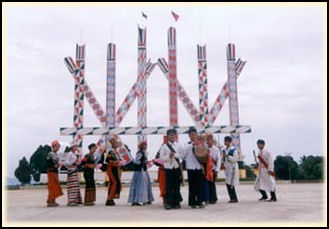 Society is organized along patrilineal lines with each family belonging to a clan, which have a hierarchal rank, and they in turn are broken into lineages, which also have a rank based on closeness to the common ancestor. People have traditionally been divided into two classes — commoners (darat ni) and aristocrats (du ni) — often based on the clan in which one is born or marries into. Chiefs were often hereditary. They traditionally oversaw some ceremonies, were responsible for reciting genealogical myths and took tribute of the hind quarters of killed animals but had little say in how land was used and other matters. In China, the chief system was largely terminated by the Communists. In Myanmar, it is still alive in some places but has been rejected in favor of a more egalitarian system in others.
Society is organized along patrilineal lines with each family belonging to a clan, which have a hierarchal rank, and they in turn are broken into lineages, which also have a rank based on closeness to the common ancestor. People have traditionally been divided into two classes — commoners (darat ni) and aristocrats (du ni) — often based on the clan in which one is born or marries into. Chiefs were often hereditary. They traditionally oversaw some ceremonies, were responsible for reciting genealogical myths and took tribute of the hind quarters of killed animals but had little say in how land was used and other matters. In China, the chief system was largely terminated by the Communists. In Myanmar, it is still alive in some places but has been rejected in favor of a more egalitarian system in others.
In principle the rank distinction between aristocrats and commoners is rigid but in practice it is not. F. K. Lehman wrote: The politics of marriage alliance combined with the tendency for local lineage segments to constitute separate entities occasionally allows a rising commoner lineage of wealth and power to get a major wife from a lineage in an aristocratic clan that may have fallen on hard times, if the alliance is suitable to the two parties and the prices paid are appropriately inflated. [Source: F. K. Lehman, e Human Relations Area Files (eHRAF) World Cultures, Yale University]
Anthropologists have commented on the different versions of the political system among different Kachin communities. Gumchying Gumtsa chiefs are the ritual models of chiefdom. Their authority derives from their monopoly of priests and bardic reciters of genealogical myths, through which ritual specialists they control access to the spirits who make human occupancy of the land possible. They claim the right to various services and dues from their subjects, notably a hind quarter of all animals (wild and domestic) that are killed in the tract, and so are called “thigh-eating chiefs.” Gumlao communities reject on principle the hereditary privileges of chiefs. In particular, they believe that all aristocrats of the community are equal, that is, all householders who can get someone to sponsor the essential Merit Feasts and sacrifices.
Disputes are usually settled with the help of chiefs and village elders. For those involving adultery or other sex scandals, the perpetrators were often required to “face wash” by sacrificing cattle. In matters such as theft or failure to pay a debt it was quite acceptable for the victim to steal cattle from the perpetrator.
See Separate Articles: KACHIN MINORITY factsanddetails.com; JINGPO LIFE AND CULTURE factsanddetails.com ; JINGPO MINORITY: HISTORY, RELIGION AND FESTIVALS factsanddetails.com ; Kachin News kachinnews.com ; KACHIN INSURGENCY AND UNREST IN KACHIN STATE factsanddetails.com; MYITKYINA, KACHIN STATE AND NORTHEASTERN MYANMAR factsanddetails.com PUTAO AND THE WILD FORESTS AND HIGH MOUNTAINS OF FAR NORTHERN MYANMAR factsanddetails.com
Kachin Life
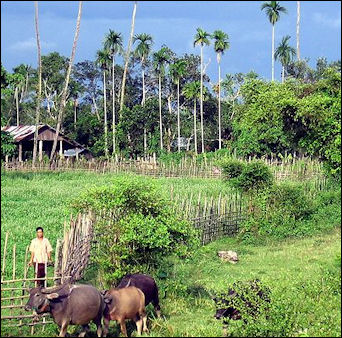
The Kachin chew betel nut and tobacco and sometimes smoke opium. Rice is used to make beer and a distilled liquor. Some Kachin families own pack-ponies or even elephants, and are expected to take good care of them. Many keep dogs for hunting and as pets.
E. Mirante wrote in the “Worldmark Encyclopedia of Cultures and Daily Life”: “Most Kachins live in houses built of bamboo and wood, up on stilts or low to the ground with dirt floors. The hills are cold and foggy, sometimes even snowy, so houses have wood stoves or open hearths inside them. In stilt houses, people sit and sleep on the floor; in the single-level houses, they sit on wood or rattan chairs and sleep on bamboo platforms. Much of what is used by the Kachins is crafted by them of bamboo or wood, but trade goods do enter from China and India. The Kachin State has few road, railway, or air links. Heavy trucks, motorcycles, elephants, ponies, and mules are typical modes of transportation over the many hills and mountain passes. [Source: E. Mirante, “Worldmark Encyclopedia of Cultures and Daily Life”, Cengage Learning, 2009 *]
Men tend to do heavy work such as plowing, slashing and burning, hunting and watering the paddy fields. Women do weaving weeding, harvesting, carrying and processing crops, gathering wild fruits and vegetables, and household chores. Both men and women cook and sell stuff in the markets. Young people often help their parents in the fields or shops. In the towns and cities, it is common for teenagers to be active in church groups, and some even travel to other parts of Burma for church meetings and to seek converts to Christianity. *\
Kachin Customs
E. Mirante wrote in the “Worldmark Encyclopedia of Cultures and Daily Life”:“Kachins are raised to value cooperation and an uncomplaining spirit. Children are discouraged from fighting with each other and encouraged to share their possessions and food. Although they have been known as brave, tough warriors in battle, adult Kachins rarely seem to argue among themselves. [Source: E. Mirante, “Worldmark Encyclopedia of Cultures and Daily Life”, Cengage Learning, 2009 *]
Kachins shake hands when introduced and when greeting or saying goodbye. They are generous hosts and always offer food, or at least tea, to visitors. The guest is expected to politely refuse the refreshments at least once—perhaps several times to be "overcome" by the hosts' insistence. Then they will please the hosts if they eat large amounts of the food offered. Particularly honored guests, such as those who have endured great difficulty to travel from far away, may be given a special welcoming ceremony. They are presented with bamboo cups of rice wine and a basket containing cooked chicken and rice wrapped in leaf packets, to be shared, and may be given a sword and shoulder bag (if male) or Kachin clothing (if female). *\
“What wealth Kachins manage to acquire is usually in the form of jewelry, which is easily portable. A family's "bank account" takes the form of rings or earrings made of the gold and colorful jade or amber found in Kachin State, and sometimes elaborate silver wedding jewelry. In general, the Kachins place more value on friendships and kinship than on material possessions, and even small children would usually rather play games with other children than play with toys. *\
Kachin Family, Clans and Women
Few Kachins remain single and large families — six or more children — have traditionally been the norm. Some Kachins believe that since their ethnic group is few in numbers, having many children is important to their survival as a culture. Traditionally, after a marriage occurs the wife returns to live with her family until the first child is born. Usually the youngest son inherits his father's house and position, if any, while much of the father’s movable property is given out in the father's lifetime, as dowry to his daughters and as marriage settlements on the older sons. The youngest son is expected to support the parents in their old age and arrange their funerals. A childless man's estate reverts to his brothers or lineage mates and their heirs.
Clans are very important. The Kachin marry outside their clan or village. The clans are divided into major lineages and these into lesser segments and local lineage groups. There is a fixed relationship between clan names even in different languages and dialects. The aristocratic clans are, in order of prestige, are Marip, Lahtaw, Lahpai, N'Hkum, and Maran. Some traditional lineage genealogies recited by bards are very long, though the number of generations back to the common ancestor seems to be a fixed number. Clans are sometimes spoken of as if they were tribes because they are often associated with a particular chief or village. Among the Jinghpaw, a wife acquires no membership in her husband's clan and lineage, but in Gauri she acquires limited membership. This difference corresponds to differences in the ease of divorce and in the recovery of marriage payments. I such cases, Jinghpaw recovery is made from the wife's family, while in Gauri it is made mainly from her lover, in cases of adultery. When outsiders are adopted as Kachins, they are assigned to one of the clans and given a Kachin name that, in part, comes from their birth-order in their family. [Source: F. K. Lehman, e Human Relations Area Files (eHRAF) World Cultures, Yale University]
Kinship terminology distinguishes relatives on the father's and mother's side of the family and lumps each group into a single category. Omaha-type cousin terminology is observed. In this system, relatives are sorted according to their descent and their gender. An individual’s father and his brothers are merged and addressed by a single term, and a similar pattern is seen for the individual’s mother and her sisters.
E. Mirante wrote in the “Worldmark Encyclopedia of Cultures and Daily Life”:“In old Kachin society, women's status was considerably lower than men's, but this is changing as women seek more education and stand up for themselves. Kachin women often own small shops or restaurants, and in KIO-controlled areas they are particularly active in education and healthcare, as well as serving as soldiers. In those areas they have formed a women's organization that runs kindergartens and promotes good nutrition and economic empowerment. In the cities and towns, women are active in church activities and some are in popular Christian singing groups. Kachin society tends to be conservative and somewhat disapproving of gender identities other than heterosexuality. [Source: E. Mirante, “Worldmark Encyclopedia of Cultures and Daily Life”, Cengage Learning, 2009 *]
Kachin Marriage and Courtship
Marriage among the Kachin usually occurs in the late teens or early twenties. The clan system determines who marries whom. The most preferable match for a man to marry his mother’s brother’s daughter, or a match that brings two lineages together in an alliance. In many cases if such a match is not made fines have to be paid to the mother’s brother. With everyone belonging to one of the main clans, it is common knowledge which clans a girl or boy can marry into, and which are taboo. [Source: E. Mirante, “Worldmark Encyclopedia of Cultures and Daily Life”, Cengage Learning, 2009 *]
Young people are quite free to flirt and date. Premarital sex is common. Many villages have a “public house” were adolescents can go and have sex. Young people have traditionally gathered here for singing, recitation of love poetry and lovemaking. Couples involved in trysts were not required to get married but a girl’s family could get fined if the girl got pregnant.
Marriages however are more serious and usually arranged. The groom’s family is required to pay a bride price, usually in the form of buffalo, cattle, horses, gongs and/or palajing (a kind of silk or nylon scarf). The amount is determined by the number of relatives the bride has. In return, the bride’s family gives a gift to the son, often a spear, knife or sword, and preferably a gun worth half the value of the bride price. Bride price negotiations can be complex and lengthy and often involves go-between. Sometimes the bride price is paid out over several years. If the groom’s family can not come up with the full amount, the groom may spend several years doing bride service.
F. K. Lehman wrote: Polygyny, not common, is allowed, and often arises from the obligation to take on the widow of a real or classificatory brother. Some chiefs have several wives, some of them Shan or Burmese, and these cases arise from the need for marriages of state. Exogamy(marrying outside a clan) is more theoretical than strict, and it is quite possible to marry even a somewhat distant clan member. In some regions a form of marriage called hkau wang magma is practiced, which prohibits marrying into a lineage from which a wife has been taken until the fourth generation, and requires a marriage with a mother's brother's daughter's daughter's daughter (MBDDD). In such cases the MBDDD may turn out to be in one's own lineage, and the requirement must still be met. [Source: F. K. Lehman, e Human Relations Area Files (eHRAF) World Cultures, Yale University]
See Separate Articles: JINGPO LIFE AND CULTURE factsanddetails.com
Kachin Villages and Homes
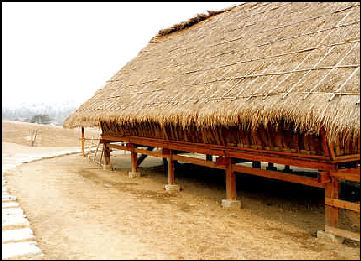 Kachin in Myanmar tend to live in villages with less than 100 households and have a sacred grove marked by pots, intended to attract good fortune from the gods, and shrines, where community sacrifices are held. In the old days, large villages were often stockaded for protection. Villages with a strong hereditary chief had longhouses, up to 30 meters long and 10 meters wide, where the chief lived with his large extended family
Kachin in Myanmar tend to live in villages with less than 100 households and have a sacred grove marked by pots, intended to attract good fortune from the gods, and shrines, where community sacrifices are held. In the old days, large villages were often stockaded for protection. Villages with a strong hereditary chief had longhouses, up to 30 meters long and 10 meters wide, where the chief lived with his large extended family
The Kachin traditional house is constructed like that of a village elder. Construction materials are wood, bamboo and thatch. The left side of the house is used like the back of any kinds of houses. The kitchen, wooden mortar and pestle. firewood and household goods are kept there. Traditional utensils are depicted on the pillars of the house in the form of paintings. At the back of the house there is a ground where the traditional Manaw can be held. If the house has a Manaw pillar—which is sort of like a totem pole—the owner of the house is the elder who can hold Manaw Festival which is the traditional Kachin Festival. The Moekyoe Nat room or compartment for spirits is found only in the house of national race elders. The living room, shrine for Nats, front room, kitchen and room for virgins are seen separately.
Describing the inside of a Kachin house, Steven Martin wrote in Time magazine, “Their house was a modest structure of concrete and wood but the sitting room was decorated with an impressive collection of posters. Among them was a concert shot of the Scorpions and, next to that, a classic of Bruce Lee that I hadn't seen since my youth: the scene from Enter the Dragon in which Bruce is sporting two dramatic claw marks across his chest, his mouth wide open mid-caterwaul. High up on the opposite wall was a shelflike shrine supporting the images of Jesus, Mary and the Buddha. Though I have spent the better part of two decades in Southeast Asia, this was the first time I had seen Christ and the Buddha share the same household altar. I was admiring the shrine when Myo Aung entered the room. “My father was Burman and my mother was Kachin. Burmans are always Buddhist but many Kachin are Christians.” I complimented him on the shrine, and we set out to meet one of his friends. [Source: Steven Martin, Time magazine, 2002]
Houses of important people have a hornlike-ornament at the front of the roof peak. Chief’s homes have the head of a sacrifices buffalo displayed with harvest boards and posts that signify claims of authority and linkage to the spiritual world. At the end of the living area inside a house is a space for household and ancestor spirits. At the front of the house are alters and X-shaped posts on which cattle are bound when they are sacrificed. The skulls and horns of water buffalo are hung on the walls of bamboo houses for exorcism purposes and as reminder of buffalos which have worked for their families.
Each house has a granary. Chores such as weaving and pounding rice are done under an overhanging front gable. Under the house is an area for animals. The up slope rooms are used for sleeping while the downslope ones are left open for cooking, storage and entertainment.
Kachin Food
Many Kachin eat rice with vegetable stew three times a day, sometimes meat or fish. They generally don’t eat the meat of goats, sheep, monkeys, horses, dogs and cat. Many insects have found a place in the diets of the Kachins as well as in the diets of the Burmese, Karens, Chins, Shans, Talaings and others.
According to the “Worldmark Encyclopedia of Cultures and Daily Life”:“The Kachins grow some cold-climate foods such as potatoes, which are not so common elsewhere in Myanmar. These crops are combined in Kachin cooking with wild game such as boar and venison, domestically raised chicken and goat, and edible plants gathered in the forest. Rice is grown in hillside fields or brought as a trade commodity from China. The Kachins are known for eating large quantities of rice and whatever accompanying curry they can afford. If they can afford it, they typically eat a few bowls of rice with their late-morning breakfast and a few more with the late-afternoon supper. Tea or coffee (a luxury) is served with fruit, crackers, or cookies during the rest of the day.” Bamboo shoots, either salted or preserved is a common side dish and snack. Typical vegetables include pumpkin, pumpkin leaf, mustard, mushroom, okra, long beans, cauliflower and chying lap. [Source: E. Mirante, “Worldmark Encyclopedia of Cultures and Daily Life”, Cengage Learning, 2009 *]
Kachin dishes include: 1) Shat Jam, a rice dish made from boiled rice, beans, carrots, mushrooms, and fried onions and may include meat such as chicken, pork or beef (known as Kachin Danbauk in Burmese-speaking areas); 2) Silu, a curry made with rice powder and chicken, chilli, basil, garlic, and machyang si; 3) Shan Hkak, minced beef mixed with basil, garlic, ginger, chilies and pepper; 4) Si Pa, a vegetable curry made with rice powder; and 5) Japhtu, a spicy side dish made of pounded chilies and garlic. There are many variations such as adding dried beef, fish, banana bud, or tomatoes. [Source: Wikipedia]
Kachin Clothes
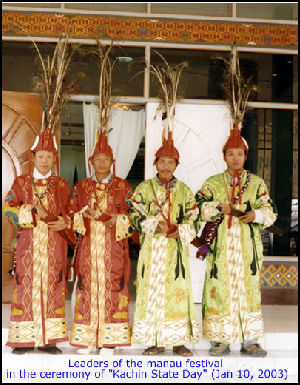
The Kachin traditionally wore homespun thick cotton jackets with baggy trousers for men and wrap-around sarongs for women. The traditional costume consisted of a black shirt, edged with a red panel tied around the waist with a blue sash. Sometimes black, long-sleeve jackets are worn over white and black blouses with numerous strings of small red, blue and yellow beads covering the chest. Kachin longyi (sarong) have checks and stripes of black, green and deep purple. Many have a “manaw” stripes on a red or black background are made of wool. The Kachin longyi is quite short. Some Kachin groups tie it and wear many loose cane belts. At their legs, they tie two pieces of cloth.
Kachin men mainly wear Shan-style and Western clothes. At festivals many young Kachin males wear white turbans while older men favor black turbans. Kachin men in traditional clothes wear shirts, traditional jackets, sarong-like longyis or slacks. They also wear turbans or headdresses with tassels, hanging loose on one end on the right of their head. They keep a sword and a shoulder bag as an ornament. Bamar, Kachin, Mon, Shan, Kayah and Rakhine men wear a traditional jacket called a “teik -pon” over their “eingyi”. It is white, grey, black or terracotta in color.
Kachin women have traditionally use belt looms to produce cloth with floral-geometric designs. Women wear long dresses called “thin-dai” that decorated with beautiful stitching. Kachin “eingyi “has only black color and it is very interested and very beautiful because it is decorated by many pieces of silver. In some places, women wear bright red skirts with a yellow border, fastened around the hips with a cane belt. Kachin women adorn themselves with hand-woven clothes with flowery and checkered designs. A number of silver coins and studs are attached to their blouses. Over a black jacket is a huge collar made of silver disks, which cover the shoulders, chest and upper part of the back. Like the Kayin Kayah, Kayin, Shan and Chin, , Kachin, women tie a lovely band on their head.
Jinghpaw women are famous for wearing dozens of silver-globule medallions arranged across the front of and shoulders of their blouses. Ball-like silver ornaments and silver fringe hang from the collar. These are worn with matching gaiters and sandals Many Kachin wear tall black hats with circular silver earrings and gaiters that reach from the knee to the ankle. . The Lashi wear a similar costume but in blue and white with blue turbans and red bead necklaces.
Kachin often knit their own sweaters with yarn imported from China, and also knit warm outfits for children and babies. Children often wear several layers of clothing to school in the mountains because the buildings are unheated. A type of Kachin sarong with traditional embroidery on a black cotton background became a symbol of democracy throughout Myanmar after r Aung San Suu Kyi wore it. [Source: E. Mirante, “Worldmark Encyclopedia of Cultures and Daily Life”, Cengage Learning, 2009]
Kachin Culture, Folklore, Art and Sports
Kachin literature includes folk tales, legends and ballads. Many of them are a kind or oral history about chiefs passed down from generation to generation. Kachon have a tradition of bards known as jaiwa. They are rare these days and traditionally preserved and recited genealogies and associated myths at the Manau feasts. in which chiefs and other high aristocrats proclaim and validate the ancestral sources of their authority. [Source: F. K. Lehman, e Human Relations Area Files (eHRAF) World Cultures, Yale University]
E. Mirante wrote in the “Worldmark Encyclopedia of Cultures and Daily Life” in 2009: “Kachins traditionally believed that the original ancestor of their tribes was a blacksmith. They thought that the moon was the spirit of a young girl, and some girls are thought to be able to foretell the future by communicating with the moon. Particularly among Animist Kachins, there is a belief in malicious witches called phi, including the Yu Phi, who disguise themselves as animals or insects to harm people or animals. [Source: E. Mirante, “Worldmark Encyclopedia of Cultures and Daily Life”, Cengage Learning, 2009 *]
“Kachins are talented jewelers, making ornaments from the local gold, silver, amber, and jade. They also make traditional swords with embossed silver scabbards, baskets, and bamboo drinking cups. Kachin embroidery, often using diamond-shaped designs that symbolize the mountains, is distinctive, and different patterns can identify tribes or regions. *\
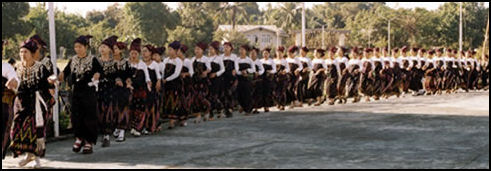
Kachin ladies dance
“Kachins enjoy playing and watching soccer, volleyball, and badminton. Some study martial arts such as kung fu. Children run races and play jump-rope games, making their own ropes by looping together collections of rubber bands. In some areas people have DVD players and karaoke machines, which are usually powered by a small generator, as electricity is in short supply in Kachin State. They often show "homemade" DVD dramas produced and acted by people in Myitkyina or Bhamo. In some places satellite dishes have been rigged up, so Kachins can watch international television such as the BBC World News and Asian MTV. Otherwise, short-wave radios are relied on for information on the outside world, as well as word on developments in Myanmar. There is very little Internet access in Kachin State, but the cities have some cafes where computer games can be played. Kachins also enjoy getting together to sing hymns or pop songs, accompanied by guitar players. Sometimes church youth groups will travel from village to village presenting Christian music shows.
Kachin Music and Dance
The principal musical instrument is the booming drum, which can be heard within a radius of 4 or 5 miles. It is a long two-faced drum made of calf or water buffalo leather. It is called the Long Drum or Great Drum. Then there are the large gongs and a flute called a "Dum Bar" on which is fixed a horn of the buffalo. The Manau dance does not feature the one-sided. "Ozi" drum or cymbals as in another Kachin traditional dance, the "Htawng Ka". [Source: Kachin National Organization |||]
Traditional Kachin music features repetitive rhythms of metal gongs. It is played mostly for dancing. Western-influenced hymns are sung at Christian church services. Love songs are popular among young people. Some churches have electronic keyboards. Guitars may accompany the hymn-singing. Pop and rock songs are popular among many Kachins. The Kachin rebel forces had small marching bands with bagpipes, like those of Scottish troops who served in Burma in the days of the British Empire. [Source: E. Mirante, “Worldmark Encyclopedia of Cultures and Daily Life”, Cengage Learning, 2009 *]
The best-known Kachin dance is the ton-kha, in which lines of men and women form a circle and step in and out holding kerchiefs in their hands. Ar festivals, To the music of gongs and flutes the Kachin do snake dances around the poles with the buffalo skulls, as well as around nat poles which are reminiscent of totem poles. During the snake dance, which are led by chiefs wearing feathered head dresses, the dancers often go into trances.
See Manaus Under KACHIN MINORITY factsanddetails.com
Kachin Manau Dances
The ‘Manau dance’ is performed by two groups with two persons leading each group. Behind the leaders come the members of various clans, the Maru (Lachieik), Lashi, Azi, Zaiwa, Rawang, Lisu and Jinghpaw in full ceremonial national dress. All those following behind have to watch the leaders and follow their dance step and change steps and rhythm when they do. When the dance begins the Manau leaders and their respective group members face the guests in the pavilion and perform a dance or obeisance. Then they turn towards the Manau poles and bow and dance in homage. The two groups first dance in rows, gradually forming crescents and finally forming one large circle that goes round and round the Manau poles, but later as the drum beat and rhythm of the music change the large circle converges to the center, and all bow from head and waist and then step backwards to form a wide circle again. When all the dance steps have been completed, the guests and anyone who wishes to are invited to join in the dance. Sometimes, the leaders form the patterns painted on the Manau poles with special dance steps. |||
A Kachin ‘N’Htu’ or sword is an important feature or the Manau Dance and is held upright by the dancer. In Kachin culture the sword or knife is the most unique and indispensable tool of life. W ith this knife, land is cleared for cultivation, trees felled for timber to build house and vows are exchanged with the Kachin ‘n htu’ as witness in betrothal ceremonies much as a Bible is used in Christian ceremonies. |||
It was also with this sword that Kachin nationalists revolted against colonial rule. So it is no wonder that the Kachin sword features so prominently in the most important of the Kachin Manau festivals. The Manau dance consists of at least 7 to 9 dance movements and the dance itself last form a minimum of one to three hours to a maximum of four to eight days. Any one, irrespective of race, religion or status, is welcome to participate in this traditional dance festival. It is a very pleasant enjoyable way to get to know at first hand the culture and traditions so dear to the heart of the Kachin peoples. With this dance can also be strengthened the foundations of friendship and national unity. |||
Education and Health in Kachin State
E. Mirante wrote in the “Worldmark Encyclopedia of Cultures and Daily Life”: “Educational opportunities are few in the Kachin State. There is a severe shortage of schools, teachers, and educational materials, especially in rural areas. There is discrimination against Kachin students in Myanmar's educational system, and few opportunities for higher education exist in the Kachin State. Some high school graduates attend Bible study academies in the cities. Little is written in the Kachin language, so most of the school texts are in Burmese and very outdated. Kachin parents often express the hope that their children will get more of an education than they were able to. In 2008 Kachin students in Myitkyina were active campaigners for a "No" vote on a national constitutional referendum held by Myanmar's military government, which was pressuring the population to vote "Yes." [Source: E. Mirante, “Worldmark Encyclopedia of Cultures and Daily Life”, Cengage Learning, 2009 *]
“Many Kachin mothers now give birth in a clinic or hospital, if there is one nearby; otherwise, their babies are born at home. Infant and child mortality rates are high in most areas of the Kachin State, mainly due to malaria, except where the elevation and cold temperatures prevent malaria-carrying mosquitoes. *\
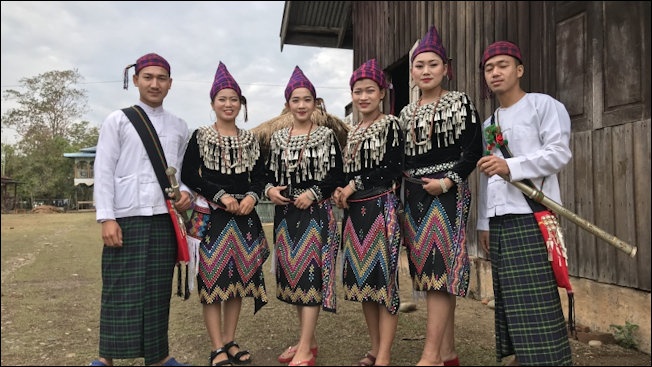
“The Kachins are living in an ongoing health crisis. They have been subject to unchecked epidemics of cholera, plague, and HIV/AIDS. Malaria, including the deadly blackwater fever, is rife in low-lying areas, as are tuberculosis and other lung diseases throughout the Kachin State. With very few trained doctors available, fake "injection doctors" roam the hills in their place, giving malnourished people vitamin shots with dirty needles, thereby spreading the HIV/AIDS virus and other ailments among unknowing people. Traditional healers can be more beneficial, and the many medicinal plants of the Kachin State provide the hope of cures for many diseases—if logging does not destroy the forests before they can be properly studied. *\
Kachin Economy
Traditionally, Kachin have been subsistence farmers and have had no other jobs or specialized skills other than making earthenware and weaving mats, baskets and house walls from bamboo, cane and grass. Pottery, tools and metal objects are obtained from the Shan or Chinese. Cattle, buffalo, pigs dogs and chickens have traditionally been raised for sacrifices but not for selling or eating. Pigs are fed mash in the evening and left to scavenge in the day. Some hunting is done with pellets, bows and guns. Fishing has traditionally been done with traps and poison
The Kachin get most products they need from state stores or markets. In most cases they trade or use money earned from the agricultural product they grow. They also collect some forest products such as mushrooms, fruits and herbal medicines. They are not known as being traders or peddlers but they do earn money from cross border trade and smuggling between China and Myanmar.
Kachin involvement in the opium trade is a matter of some dispute. Opium poppies were cultivated in Kachin areas but it was believed to have been done mostly by non-Kachin groups. It is assumed that chiefs earn money from opium carried across their territory. After an HIV/AIDS epidemic spread through the most remote parts of the Kachin State, largely from injections of heroin and other drugs with shared needles, the Kachin Independence Organization responded in 1991 by banning opium growing and heroin trading. they successfully substituted food crops for opium poppies, but in the Burmese government-controlled areas, the drug trade continued. [Source: E. Mirante, “Worldmark Encyclopedia of Cultures and Daily Life”, Cengage Learning, 2009 *]
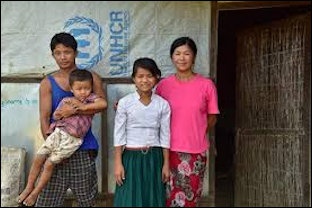
E. Mirante wrote in the “Worldmark Encyclopedia of Cultures and Daily Life”: “Joining the military has long been a favored occupation for young Kachins. In the colonial period they joined the British Army, and at independence, the Burmese Army. Thousands still are enrolled in the Kachin Independence Organization's armed forces, although a ceasefire is in effect. For those less interested in the military life, religious studies are popular.
“Jade is very important to the Kachins. Jadeite, the most precious kind of jade, is found in large quantities only in Kachin State. The bright green jade is best known, but it also comes in white, lavender, blue, and honey-colored shades. Huge boulders and tiny pieces of jade are brought out through government controlled areas, for sale around the world. Kachins working at the big jade mines have often been mistreated and are especially susceptible to drug and alcohol abuse. In the cities and jade mining region, many have turned to heroin abuse. *\
“A massive increase in logging in recent decades has decimated the great temperate rainforests of the Kachin State in all but the most remote regions of the far north. Logging trucks move back and forth, day and night, carrying hardwood logs from Kachin forests for sale in neighboring China and India. Environmental concerns have also been raised about gold mining by companies from China that enter Kachin State in joint ventures with Myanmar's military government or the KIO. The gold miners use highly toxic mercury when processing ore dredged from the rivers, and gold mining also erodes river banks. *\
Kachin Agriculture
The Kachin practice both terraced and slash and burn agriculture. Wet rice is grown in the terraces and dry rice and other crops are grown and slopes that have been slashed and burned. Water buffalo are used as plow animals for wet rice. Slash and burn farmers traditionally used heavy-handled hoes to break the soil, sticks to make holes for planting and knives and sickles for harvesting. The mountainous climate and rocky soil make agriculture hard work in most areas.
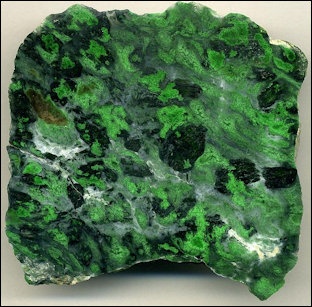
Jade found in Kachin State
The Kachin have traditionally prepared their fields in March, planted before the summer monsoons and harvested in October. Grain is threshed under the hooves of buffalo and stored in granaries. In the old days when slash and burn agriculture was mainly practiced the forest and farm lands were collectively owned. In China, farmers now largely operate under a contract system with the state owning the land and farmers cultivating it in return for paying taxes or turning over part of their harvest to the state. In Myanmar, chiefs decide who cultivates the slash-and-burn agricultural land. Irrigated land is often privately owned and can be inherited.
The Kachin raise a large variety of crops including maize, buckwheat, sesame, millet, tobacco, soybeans, beans, cucumbers, wax gourds, and various kinds of pumpkins. Vegetables and fruits are grown in household gardens. Opium used to be grown for money but now farmers grow cotton and sugar cane as their primary cash crops. In Putao's valley oranges and other fruits are grown.
Image Sources: Kachin Myitkyina website, Nolls Chiina website, Beifan Joho maps
Text Sources: New York Times, Washington Post, Los Angeles Times, Times of London, National Geographic, The New Yorker, Time, Newsweek, Reuters, AP, Lonely Planet Guides, Compton’s Encyclopedia and various books and other publications.
Last updated September 2022













